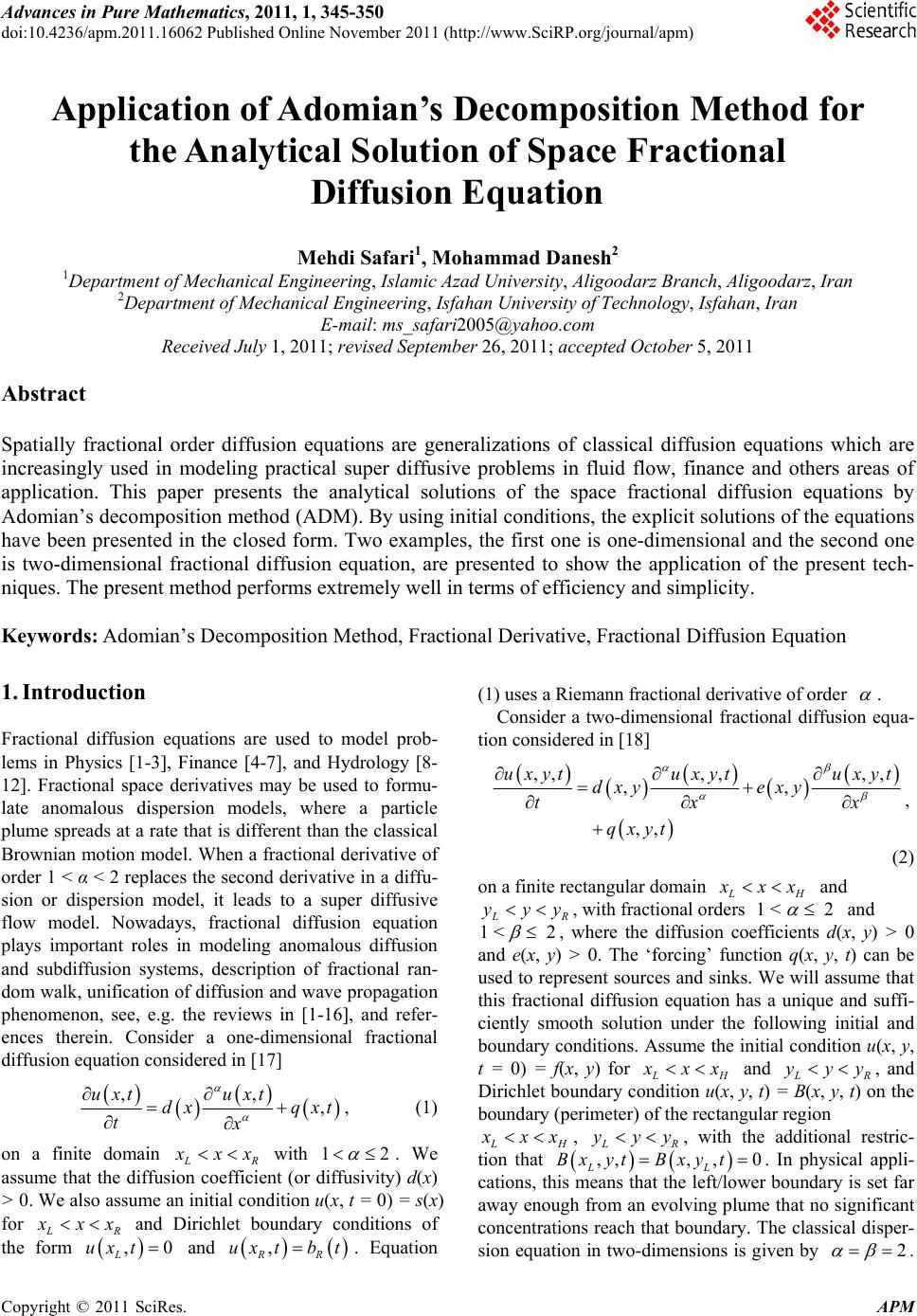 Advances in Pure Mathematics, 2011, 1, 345-350 doi:10.4236/apm.2011.16062 Published Online November 2011 (http://www.SciRP.org/journal/apm) Copyright © 2011 SciRes. APM Application of Adomian’s Decomposition Method for the Analytical Solution of Space Fractional Diffusion Equation Mehdi Safari1, Mohammad Danesh2 1Department of Mechanical Engineering, Islamic Azad University, Aligoodarz Branch, Aligoodarz, Iran 2Department of Mechanical Engineering, Isfahan University of Technology, Isfahan, Iran E-mail: ms_safari2005@yahoo.com Received July 1, 2011; revised September 26, 2011; accepted October 5, 2011 Abstract Spatially fractional order diffusion equations are generalizations of classical diffusion equations which are increasingly used in modeling practical super diffusive problems in fluid flow, finance and others areas of application. This paper presents the analytical solutions of the space fractional diffusion equations by Adomian’s decomposition method (ADM). By using initial conditions, the explicit solutions of the equations have been presented in the closed form. Two examples, the first one is one-dimensional and the second one is two-dimensional fractional diffusion equation, are presented to show the application of the present tech- niques. The present method performs extremely well in terms of efficiency and simplicity. Keywords: Adomian’s Decomposition Method, Fractional Derivative, Fractional Diffusion Equation 1. Introduction Fractional diffusion equations are used to model prob- lems in Physics [1-3], Finance [4-7], and Hydrology [8- 12]. Fractional space derivatives may be used to formu- late anomalous dispersion models, where a particle plume spreads at a rate that is different than the classical Brownian motion model. When a fractional derivative of order 1 < α < 2 replaces the second derivative in a diffu- sion or dispersion model, it leads to a super diffusive flow model. Nowadays, fractional diffusion equation plays important roles in modeling anomalous diffusion and subdiffusion systems, description of fractional ran- dom walk, unification of diffusion and wave propagation phenomenon, see, e.g. the reviews in [1-16], and refer- ences therein. Consider a one-dimensional fractional diffusion equation considered in [17] ,, , uxt uxt dx qxt tx , (1) on a finite domain R xx with 12 . We assume that the diffusion coefficient (or diffusivity) d(x) > 0. We also assume an initial condition u(x, t = 0) = s(x) for R xx L ux and Dirichlet boundary conditions of the form and ,t0 , R t R b tux. Equation (1) uses a Riemann fractio nal derivative of or der . Consider a two-dimensional fractional diffusion equa- tion considered in [18] ,,,, ,,xy xx ,, ,, uxytuxytu t dxy exy t qxyt , (2) on a finite rectangular domain H xx and R yyy , with fractional orders 1 < 2 and 1 < 2 , where the diffusion coefficients d(x, y) > 0 and e(x, y) > 0. The ‘forcing’ function q(x, y, t) can be used to represen t sources and sinks. We will assume that this fractional diffusion equation has a unique and suffi- ciently smooth solution under the following initial and boundary conditio ns. Assume the initial condition u(x, y, t = 0) = f(x, y) for H xx and R, and Dirichlet boundary condition u(x, y, t) = B(x, y, t) on the boundary (perimeter) of the rectangular region yyy H xx , R yyy , with the additional restric- tion that ,t,,yt ,Bxy 0 LL Bx . In physical appli- cations, this means that the left/lower bou ndary is set far away enough from an evolving plume that no significant concentrations reach that boundary. The classical disper- sion equation in two-dimensions is given by 2 . 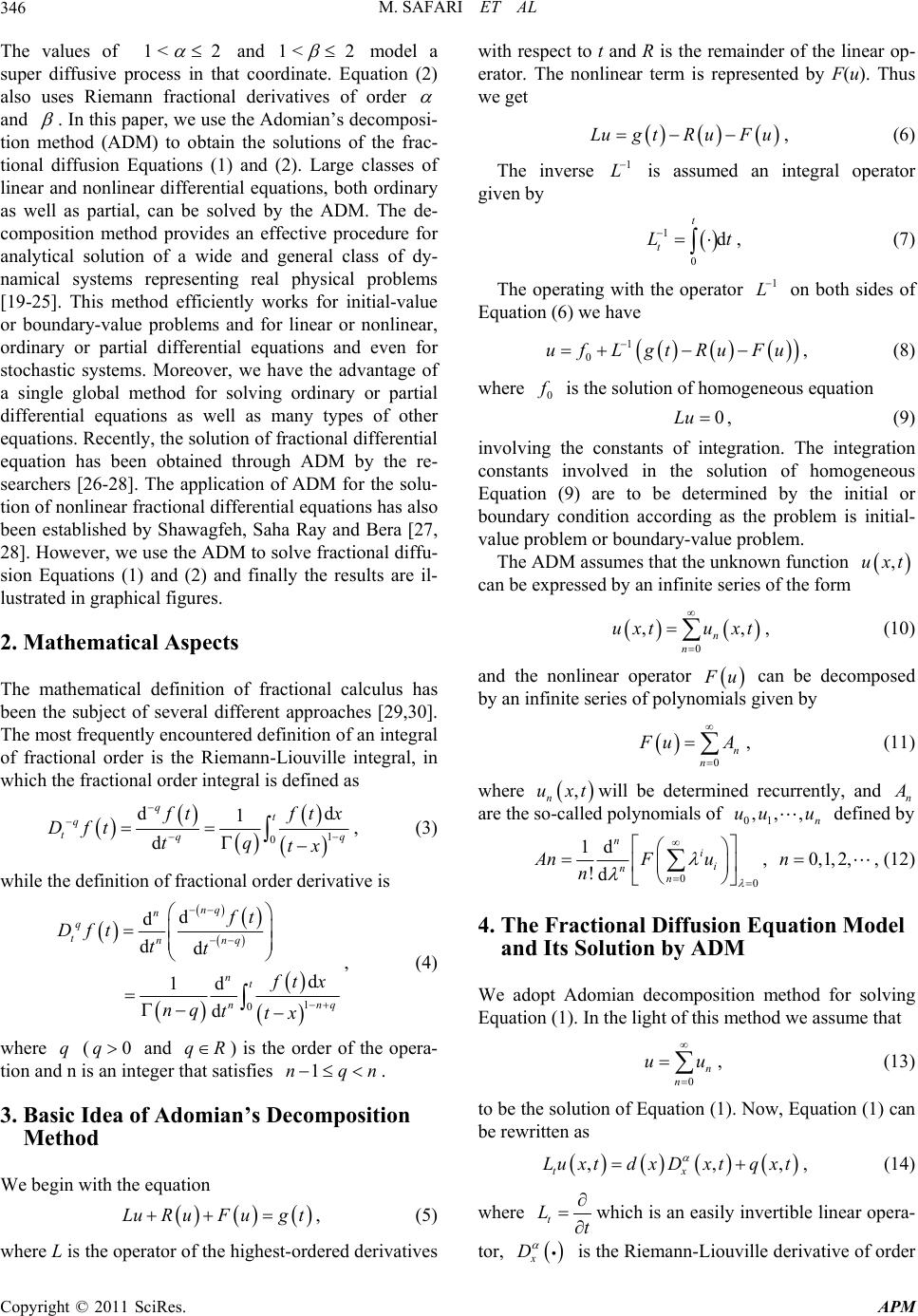 M. SAFARI ET AL 346 The values of 1 < 2 and 1 < 2 model a super diffusive process in that coordinate. Equation (2) also uses Riemann fractional derivatives of order and . In this paper, we use the Adomian’s decomposi- tion method (ADM) to obtain the solutions of the frac- tional diffusion Equations (1) and (2). Large classes of linear and nonlinear differential equations, both ordinary as well as partial, can be solved by the ADM. The de- composition method provides an effective procedure for analytical solution of a wide and general class of dy- namical systems representing real physical problems [19-25]. This method efficiently works for initial-value or boundary-value problems and for linear or nonlinear, ordinary or partial differential equations and even for stochastic systems. Moreover, we have the advantage of a single global method for solving ordinary or partial differential equations as well as many types of other equations. Recently, the so lution of fractional differential equation has been obtained through ADM by the re- searchers [26-28]. The application of ADM for the solu- tion of nonlinear fractional differential equations has also been established by Shawagfeh, Saha Ray and Bera [27, 28]. However, we use the ADM to solve fractional diffu- sion Equations (1) and (2) and finally the results are il- lustrated in graphi cal fi g ures . 2. Mathematical Aspects The mathematical definition of fractional calculus has been the subject of several different approaches [29,30]. The most frequently enco untered defin ition of an integral of fractional order is the Riemann-Liouville integral, in which the fractional order integral is defined as 1 0 d 1t q qq d d q t tftx Dft qtx t , (3) while the definition of fractional order derivative is 1 0 d d dd d 1d d nq n q tnnq nt nn ft Dfttt q tx nq ttx , (4) where ( and q) is the order of the opera- tion and n is an integ er that satisfies . q0qR1nq n 3. Basic Idea of Adomian’s Decomposition Method We begin with the equati o n LuR uFugt , (5) where L is the operator of the highest-ordered derivatives with respect to t and R is the remainder of the linear op- erator. The nonlinear term is represented by F(u). Thus we get Lug tR uFu , (6) The inverse 1 L is assumed an integral operator given by 1 0 d t t L t , (7) The operating with the operator on both sides of Equation (6) we have 1 L 1 0 uf LgtRuFu , (8) where 0 is the solution of homogeneous equation 0Lu , (9) involving the constants of integration. The integration constants involved in the solution of homogeneous Equation (9) are to be determined by the initial or boundary condition according as the problem is initial- value problem or boundary-value problem. The ADM assumes that the unknown function ,uxt can be expressed by an infinite series of the form 0 , n n uxtu xt , , (10) and the nonlinear operator u can be decomposed by an infinite series of polynomials given by 0n n u A, (11) where , n uxtwill be determined recurrently, and n are the so-called polynomials of defined by 01 ,,, n uu u 00 1d , 0,1,2, !d n i i n n AnF un n , (12) 4. The Fractional Diffusion Equation Model and Its Solution by ADM We adopt Adomian decomposition method for solving Equation (1). In the light of this method we assume that 0n n uu , (13) to be the solutio n of Equation (1 ). Now, Equation (1) can be rewritten as ,, tx Luxtdx Dxtqxt ,, (14) where t Lt which is an easily invertible linear opera- tor, x D is the Riemann-Liouville derivative of order Copyright © 2011 SciRes. APM 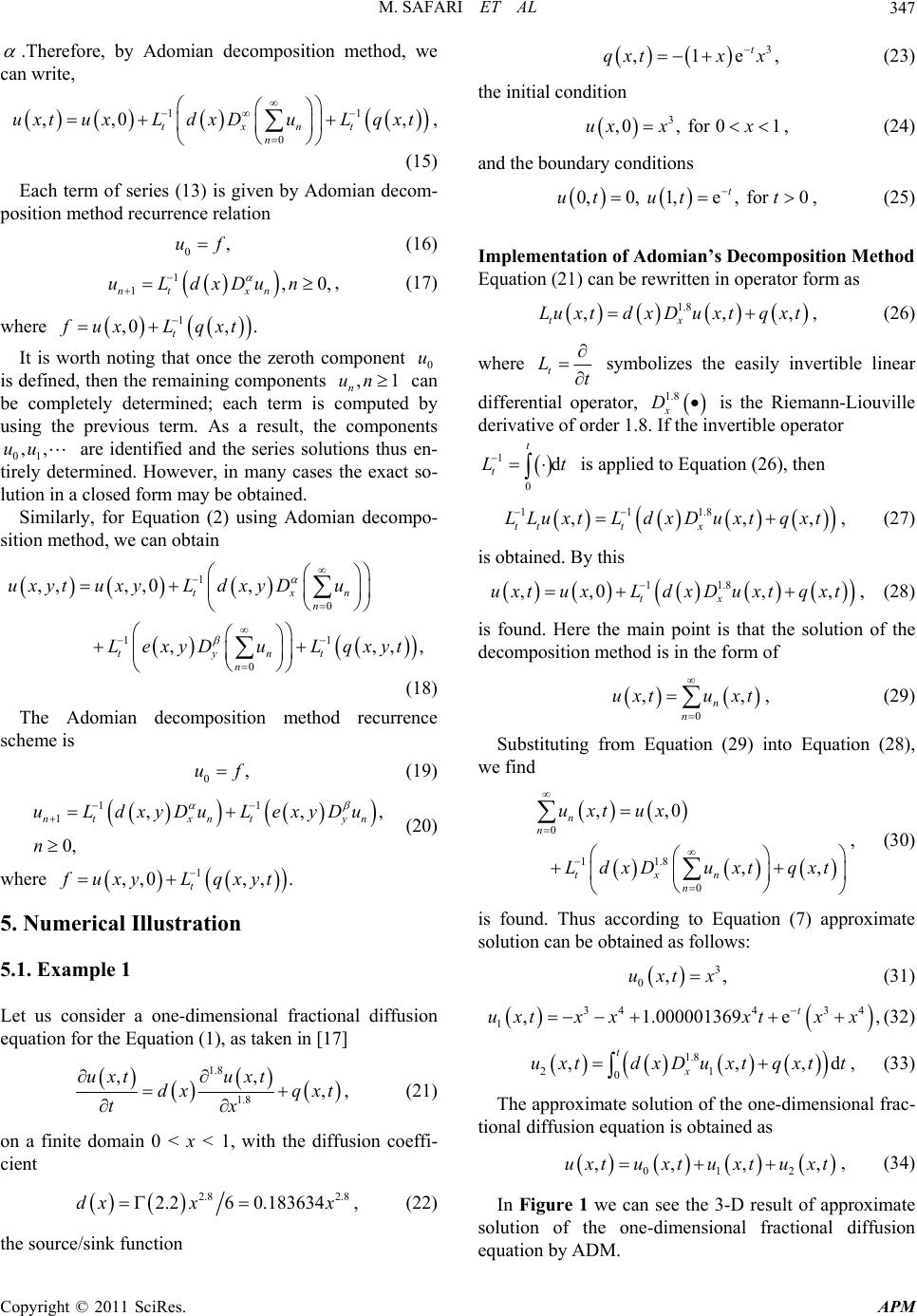 M. SAFARI ET AL347 .Therefore, by Adomian decomposition method, we can write, 11 0 ,,0 , txnt n uxtuxLdxDuL qxt , (15) Each term of series (13) is given by Adomian decom- position method recurrence relation 0,uf (16) 1 1,0 nt xn uLdxDun , , (17) where 1 ,0, . t uxL qxt It is worth noting that once the zeroth component 0 is defined, then the remaining components n can be completely determined; each term is computed by using the previous term. As a result, the components 01 are identified and the series solutions thus en- tirely determined. However, in many cases the exact so- lution in a closed form may be obtained. u 1,un ,,uu Similarly, for Equation (2) using Adomian decompo- sition method, we can obtain 1 0 11 0 ,, ,,0, ,,,, txn n tynt n uxytuxyL dxyDu LexyD u Lqxyt , (18) The Adomian decomposition method recurrence scheme is 0,uf (19) 11 1,, 0, ntxntyn uL dxyDuLexyDu n (20) where ,,0,, . t 1 uxyL qxyt 5. Numerical Illustration 5.1. Example 1 Let us consider a one-dimensional fractional diffusion equation for the Equation (1), as taken in [17] 1.8 1.8 ,, , uxt uxt dx qxt tx , (21) on a finite domain 0 < x < 1, with the diffusion coeffi- cient 2.8 2.8 2.26 0.183634dx xx , (22) the source/sink function 3 ,1e t qxtx x , (23) the initial condition 3 ,0, for 01ux xx , (24) and the boundary conditions 0,0, 1,e, for 0 t ut utt , (25) Implementation of Adomian’s Decomposition Method Equation (21) can be rewritten in operator form as 1.8 ,, tx LuxtdxDux tqxt ,, (26) where t Lt symbolizes the easily invertible linear differential operator, 1.8 x D is the Riemann-Liouville derivative of order 1.8. I f the i nvertible oper a tor 1 0 d t t L t is applied to Equation (26), then 111.8 ,, tttx LLuxtLdxD uxtqxt , , (27) is obtained. By this 11.8 ,,0 ,, tx uxtuxLdxD uxtqxt , (28) is found. Here the main point is that the solution of the decomposition method is in the form of 0 , n n uxtu xt ,, (29) Substituting from Equation (29) into Equation (28), we find 0 11.8 0 ,,0 ,, n n txn n uxt ux LdxDuxtqxt , (30) is found. Thus according to Equation (7) approximate solution can be obtained as follows: 3 0,uxt x, (31) 344 34 1,1.000001369 e, t uxtxxxtxx (32) 1.8 21 0 ,, t x uxtdxDuxt qxtt ,d, (33) The approximate solution of the one-dimensional frac- tional diffusion equation is obtained as 012 ,,,uxtuxt uxt uxt , , (34) In Figure 1 we can see the 3-D result of approximate solution of the one-dimensional fractional diffusion equation by ADM. Copyright © 2011 SciRes. APM 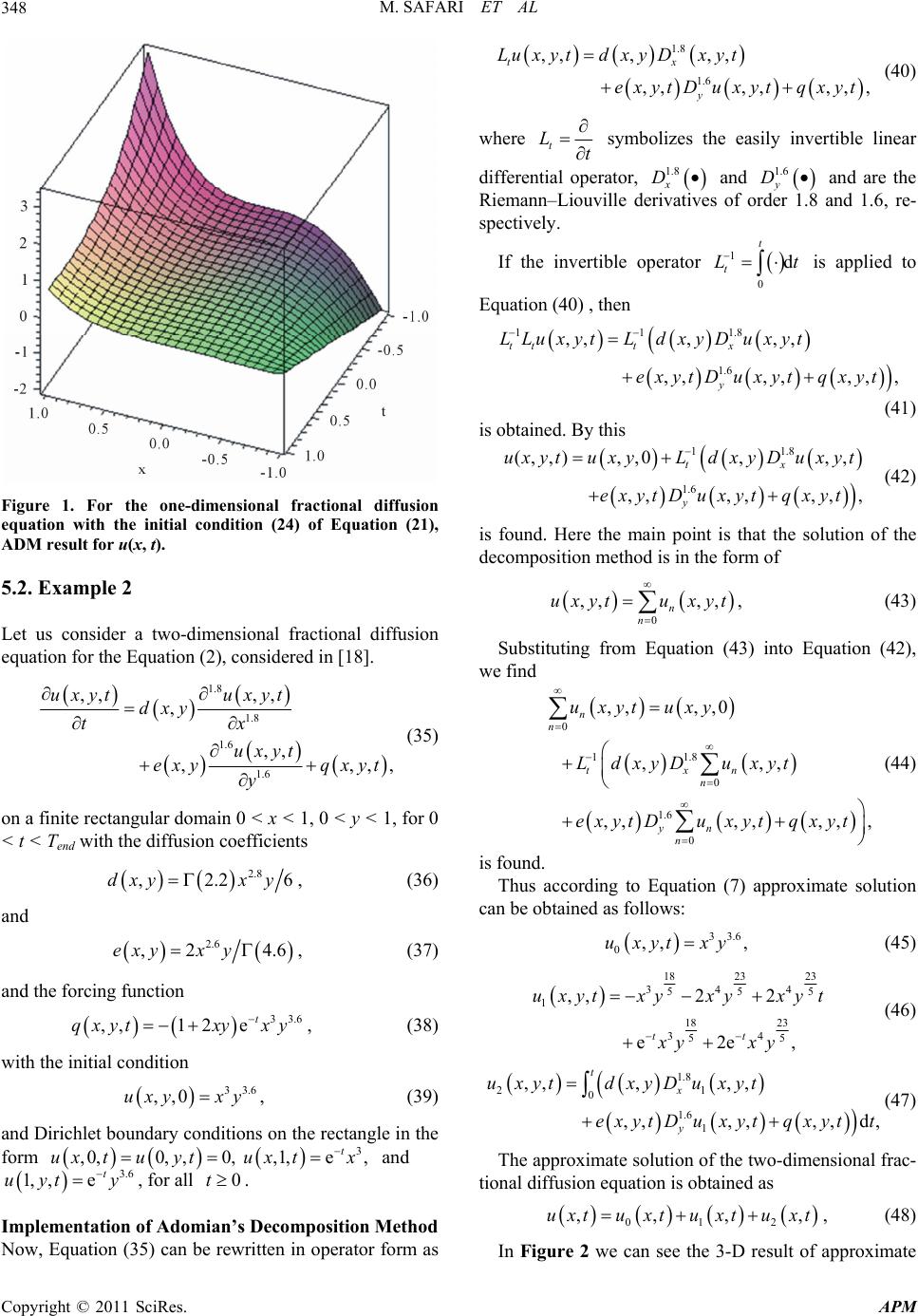 M. SAFARI ET AL 348 Figure 1. For the one-dimensional fractional diffusion equation with the initial condition (24) of Equation (21), ADM result for u(x, t). 5.2. Example 2 Let us consider a two-dimensional fractional diffusion equation for the Equation (2), considered in [18]. 1.8 1.8 1.6 1.6 ,, ,, , ,, ,,,, uxyt uxyt dxy tx uxyt exy qxyt y (35) on a finite rectangular domain 0 < x < 1, 0 < y < 1, for 0 < t < Tend with the diffusion coefficients 2.8 ,2.2dxyx y 6 , (36) and 2.6 ,2 4.6exyxy, (37) and the forcing function 33.6 ,,12 e t qxytxyxy , (38) with the initial condition 33.6 ,,0uxy xy, (39) and Dirichlet bound ary conditio ns on the re ctangle in th e form and , for all . 3 ,0,0,,0, ,1,e, t uxtuytux tx 3.6 ,e t t y 0t1,uy Implementation of Adomian’s Decomposition Method Now, Equation (35) can be rewritten in operator form as 1.8 1.6 ,, ,,, ,,,,,,, tx y LuxytdxyDxy t exyt Du xytq xyt (40) where t Lt symbolizes the easily invertible linear differential operator, 1.8 x D and and are the Riemann–Liouville derivatives of order 1.8 and 1.6, re- spectively. 1.6 y D If the invertible operator is applied to 1 0 d t t L t Equation (40) , then 111.8 1.6 ,,, ,, ,,,,,,, ttt x y LLuxytLdxyD uxyt exyt Du xytq xyt (41) is obtained. By this 11.8 1.6 (,,) ,,0,,, ,,,,,,, tx y uxytuxyLdxyD uxyt exyt Du xytqxyt (42) is found. Here the main point is that the solution of the decomposition method is in the form of 0 ,, ,, n n uxytu xyt , (43) Substituting from Equation (43) into Equation (42), we find 0 1 1.8 0 1.6 0 ,, ,,0 ,,, ,,,,,,, n n txn n yn n uxyt uxy LdxyD uxyt exytDuxytqxyt (44) is found. Thus according to Equation (7) approximate solution can be obtained as follows: 33.6 0,, ,uxyt xy (45) 18 23 23 344 55 1 18 23 34 55 ,,2 2 e2e, tt uxytxyxyxy t xy xy 5 (46) 1.8 21 0 1.6 1 ,,,,, ,,,,,,d, t x y ux ytdx yDux yt exyt Duxytqxytt (47) The approximate solution of the two-dimensional frac- tional diffusion equation is obtained as 012 ,,,uxtuxt uxtuxt , In Figure 2 we can see the 3-D result of approximate , (48) Copyright © 2011 SciRes. APM 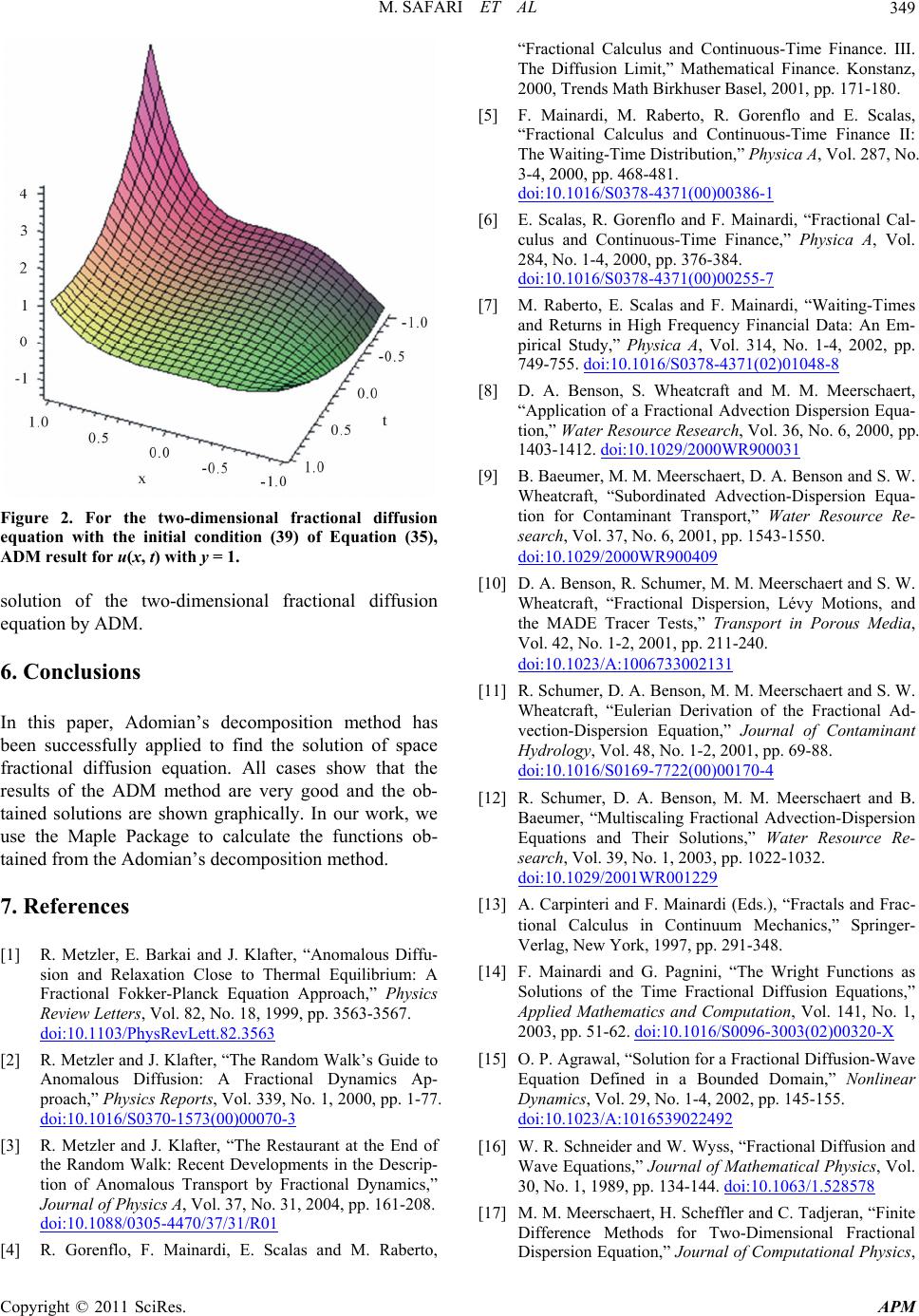 M. SAFARI ET AL349 Figure 2. For the two-dimensional fractional diffusion lution of the two-dimensional fractional diff . Conclusions this paper, Adomian’s decomposition method . References ] R. Metzler, E. Barkai and J. Klafter, “Anomalous Diffu- equation with the initial condition (39) of Equation (35), ADM result for u(x, t) with y = 1. sousion equation by ADM. 6 In has been successfully applied to find the solution of space fractional diffusion equation. All cases show that the results of the ADM method are very good and the ob- tained solutions are shown graphically. In our work, we use the Maple Package to calculate the functions ob- tained from the Adomian’s decomposition method. 7 [1 sion and Relaxation Close to Thermal Equilibrium: A Fractional Fokker-Planck Equation Approach,” Physics Review Letters, Vol. 82, No. 18, 1999, pp. 3563-3567. doi:10.1103/PhysRevLett.82.3563 [2] R. Metzler and J. Klafter, “The Random Walk’s Guide to Anomalous Diffusion: A Fractional Dynamics Ap- proach,” Physics Reports, Vol. 339, No. 1, 2000, pp. 1-77. doi:10.1016/S0370-1573(00)00070-3 [3] R. Metzler and J. Klafter, “The Restaurant at the End of the Random Walk: Recent Developments in the Descrip- tion of Anomalous Transport by Fractional Dynamics,” Journal of Physics A, Vol. 37, No. 31, 2004, pp. 161-208. doi:10.1088/0305-4470/37/31/R01 [4] R. Gorenflo, F. Mainardi, E. Scalas and M. Raberto, , 00)00386-1 “Fractional Calculus and Continuous-Time Finance. III. The Diffusion Limit,” Mathematical Finance. Konstanz, 2000, Trends Math Birkhuser Basel, 2001, pp. 171-180. [5] F. Mainardi, M. Raberto, R. Gorenflo and E. Scalas “Fractional Calculus and Continuous-Time Finance II: The Waiting-Time Distribution,” Physica A, Vol. 287, No. 3-4, 2000, pp. 468-481. doi:10.1016/S0378-4371( i, “Fractional Cal- -7 [6] E. Scalas, R. Gorenflo and F. Mainard culus and Continuous-Time Finance,” Physica A, Vol. 284, No. 1-4, 2000, pp. 376-384. doi:10.1016/S0378-4371(00)00255 i, “Waiting-Times [7] M. Raberto, E. Scalas and F. Mainard and Returns in High Frequency Financial Data: An Em- pirical Study,” Physica A, Vol. 314, No. 1-4, 2002, pp. 749-755. doi:10.1016/S0378-4371(02)01048-8 [8] D. A. Benson, S. Wheatcraft and M. M. Meerschaert, “Application of a Fractional Advection Dispersion Equa- tion,” Water Resource Research, Vol. 36, No. 6, 2000, pp. 1403-1412. doi:10.1029/2000WR900031 [9] B. Baeumer, M. M. Meerschaert, D. A. Benson and S. W. Wheatcraft, “Subordinated Advection-Dispersion Equa- tion for Contaminant Transport,” Water Resource Re- search, Vol. 37, No. 6, 2001, pp. 1543-1550. doi:10.1029/2000WR900409 [10] D. A. Benson, R. Schumer, M. M. Meerschaert and S. W. Wheatcraft, “Fractional Dispersion, Lévy Motions, and the MADE Tracer Tests,” Transport in Porous Media, Vol. 42, No. 1-2, 2001, pp. 211-240. doi:10.1023/A:1006733002131 [11] R. Schumer, D. A. Benson, M. M. Meerschaert and S. W. Wheatcraft, “Eulerian Derivation of the Fractional Ad- vection-Dispersion Equation,” Journal of Contaminant Hydrology, Vol. 48, No. 1-2, 2001, pp. 69-88. doi:10.1016/S0169-7722(00)00170-4 [12] R. Schumer, D. A. Benson, M. M. Meerschaert and B. Baeumer, “Multiscaling Fractional Advection-Dispersion Equations and Their Solutions,” Water Resource Re- search, Vol. 39, No. 1, 2003, pp. 1022-1032. doi:10.1029/2001WR001229 [13] A. Carpinteri and F. Mainardi (Eds.), “Fractals and Frac- ight Functions as tional Calculus in Continuum Mechanics,” Springer- Verlag, New York, 1997, pp. 291-348. [14] F. Mainardi and G. Pagnini, “The Wr Solutions of the Time Fractional Diffusion Equations,” Applied Mathematics and Computation, Vol. 141, No. 1, 2003, pp. 51-62. doi:10.1016/S0096-3003(02)00320-X [15] O. P. Agrawal, “Solution for a Fractional Diffusion-Wave Equation Defined in a Bounded Domain,” Nonlinear Dynamics, Vol. 29, No. 1-4, 2002, pp. 145-155. doi:10.1023/A:1016539022492 [16] W. R. Schneider and W. Wyss, “Fractional Diffusion and Wave Equations,” Journal of Mathematical Physics, Vol. 30, No. 1, 1989, pp. 134-144. doi:10.1063/1.528578 [17] M. M. Meerschaert, H. Scheffler and C. Tadjeran, “Finite Difference Methods for Two-Dimensional Fractional Dispersion Equation,” Journal of Computational Physics, Copyright © 2011 SciRes. APM 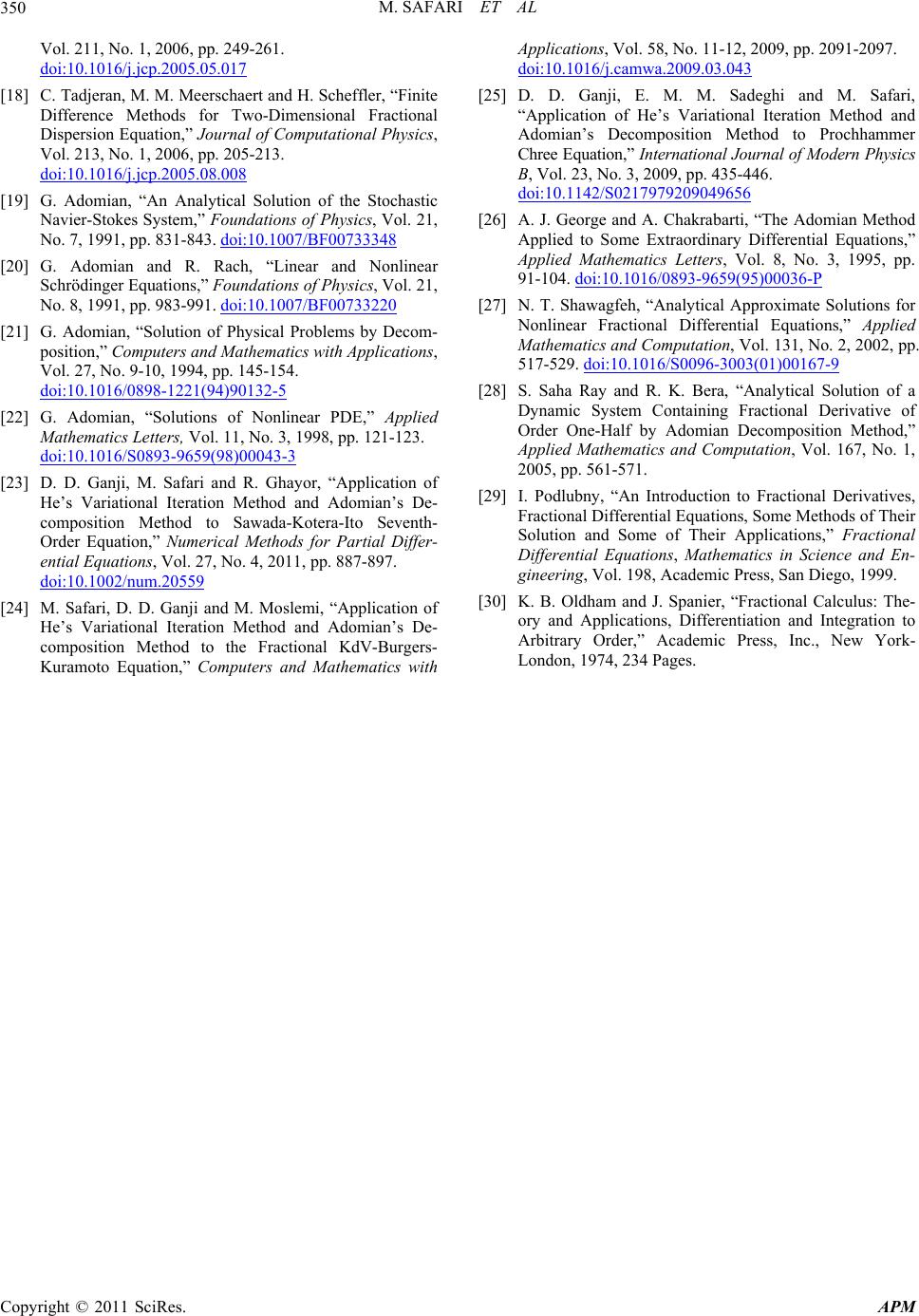 M. SAFARI ET AL Copyright © 2011 SciRes. APM 350 Vol. 211, No. 1, 2006, pp. 249-261. doi:10.1016/j.jcp.2005.05.017 [18] C. Tadjeran, M. M. Meerschaert and H. Scheffler, “Finite Difference Methods for Two-Dimensional Fractional Dispersion Equation,” Journal of Computational Physics, Vol. 213, No. 1, 2006, pp. 205-213. doi:10.1016/j.jcp.2005.08.008 [19] G. Adomian, “An Analytical Solution of the Stochastic Navier-Stokes System,” Foundations of Physics, Vol. 21, No. 7, 1991, pp. 831-843. doi:10.1007/BF00733348 [20] G. Adomian and R. Rach, “Linear and Nonlinear Schrödinger Equations,” Foundations of Physics, Vol. 21, No. 8, 1991, pp. 983-991. doi:10.1007/BF00733220 [21] G. Adomian, “Solution of Physical Problems by Decom- position,” Computers and Mathematics with Applications, Vol. 27, No. 9-10, 1994, pp. 145-154. doi:10.1016/0898-1221(94)90132-5 [22] G. Adomian, “Solutions of Nonlinear PDE,” Applied Mathematics Letters, Vol. 11, No. 3, 1998, pp. 121-123. doi:10.1016/S0893-9659(98)00043-3 [23] D. D. Ganji, M. Safari and R. Ghayor, “Application of He’s Variational Iteration Method and Adomian’s De- composition Method to Sawada-Kotera-Ito Seventh- Order Equation,” Numerical Methods for Partial Differ- ential Equations, Vol. 27, No. 4, 2011, pp. 887-897. doi:10.1002/num.20559 [24] M. Safari, D. D. Ganji and M. Moslemi, “Application of He’s Variational Iteration Method and Adomian’s De- composition Method to the Fractional KdV-Burgers- Kuramoto Equation,” Computers and Mathematics with Applications, Vol. 58, No. 11-12, 2009, pp. 2091-2097. doi:10.1016/j.camwa.2009.03.043 [25] D. D. Ganji, E. M. M. Sadeghi and M. Safari, “Application of He’s Variational Iteration Method and Adomian’s Decomposition Method to Prochhammer Chree Equation,” International Journal of Modern Physics B, Vol. 23, No. 3, 2009, pp. 435-446. doi:10.1142/S0217979209049656 [26] A. J. George and A. Chakrabarti, “The Adomian Method Applied to Some Extraordinary Differential Equations,” Applied Mathematics Letters, Vol. 8, No. 3, 1995, pp. 91-104. doi:10.1016/0893-9659(95)00036-P [27] N. T. Shawagfeh, “Analytical Approximate Solutions for Nonlinear Fractional Differential Equations,” Applied Mathematics and Computation, Vol. 131, No. 2, 2002, pp. 517-529. doi:10.1016/S0096-3003(01)00167-9 [28] S. Saha Ray and R. K. Bera, “Analytical Solution of a Dynamic System Containing Fractional Derivative of Order One-Half by Adomian Decomposition Method,” Applied Mathematics and Computation, Vol. 167, No. 1, 2005, pp. 561-571. [29] I. Podlubny, “An Introduction to Fractional Derivatives, Fractional Differential Equations, Some Methods of Their Solution and Some of Their Applications,” Fractional Differential Equations, Mathematics in Science and En- gineering, Vol. 198, Academic Press, San Diego, 1999. [30] K. B. Oldham and J. Spanier, “Fractional Calculus: The- ory and Applications, Differentiation and Integration to Arbitrary Order,” Academic Press, Inc., New York- London, 1974, 234 Pages.
|